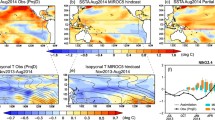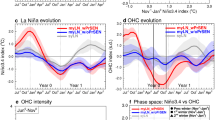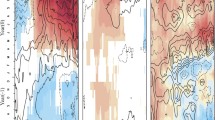Abstract
Behavior and teleconnections associated with canonical El Niño (~ 18–24 months; CE) and protracted El Niño (> greater than 3 years; PE) events are revisited in the present study. A careful look at seasonal mean of SST anomalies averaged over Niño3.4 region for the period 1980–2010 shows that El Niño episodes in the boreal winter of 1991 and 2002 do not turn into La Niña as CE events (1982–1983, 1986–1988, 1997–1998, 2009–2010). Unlike phase transition in canonical cases of El Niño followed by a neutral or La Niña event, El Niño episodes in the years 1991 and 2002 continued as weak El Niño for another 3 years. A typical signature of CE events in the tropical Indian Ocean (IO) is basin-wide warming, whereas in the case of PE events, warming remains highly localized and relatively weaker in magnitude. PE events are found to be associated with almost no subsurface ocean propagation in the equatorial Pacific Ocean (PO). PE events are linked to more frequent westerly wind bursts (WWBs) of weaker intensity and smaller timespan compared to CE cases. Strong IO warming during CE events generates easterlies in the equatorial western PO, which extend further towards the eastern PO as upwelling Kelvin waves. This upwelling Kelvin waves shoals thermocline through Ekman divergence and cools the sea surface temperature (SST) during the decay phase of El Niño. During PE cases, localized IO warming is incapable of generating significant atmospheric response in the form of easterlies and therefore frequent WWBs help in maintaining positive SST anomalies in the eastern PO.













Similar content being viewed by others
References
Allan RJ (2000) ENSO and climatic variability in the past 150 years. ENSO: Multiscale Variability and Global and Regional Impacts: 3–55
Allan RJ, D’Arrigo RD (1999) “Persistent” ENSO sequences: how unusual was the 1990–1995 El Niño? Holocene 9:101–118
Arora A, Rao SA, Chattopadhyay R, Goswami T, George G, Sabeerali CT (2016) Role of Indian Ocean SST variability on the recent global warming hiatus. Glob Planet Change 143:21–30. https://doi.org/10.1016/j.gloplacha.2016.05.009
Ashok K, Behera SK, Rao SA, Weng H, Yamagata T (2007) El Niño Modoki and its possible teleconnection. J Geophys Res Ocean 112. https://doi.org/10.1029/2006JC003798
Bamston AG, Chelliah M, Goldenberg SB (1997) Documentation of a highly ENSO-related SST region in the equatorial pacific: research note. Atmos - Ocean 35:367–383. https://doi.org/10.1080/07055900.1997.9649597
Bjerknes J (1966) A possible response of the atmospheric Hadley circulation to equatorial anomalies of ocean temperature. Tellus 18:820–829. https://doi.org/10.1111/j.2153-3490.1966.tb00303.x
Bjerknes J (1969) Monthly weather review atmospheric teleconnections from the equatorial Pacific. Mon Weather Rev 97:163–172. https://doi.org/10.1175/1520-0493(1969)097<0163:ATFTEP>2.3.CO;2
Bunge L, Clarke AJ (2014) On the warm water volume and its changing relationship with ENSO. J Phys Oceanogr 44:1372–1385. https://doi.org/10.1175/JPO-D-13-062.1
Carton JA, Chepurin G, Cao X, Giese B (2000) A simple ocean data assimilation analysis of the global upper ocean 1950–95. Part I: Methodology. J Phys Oceanogr 30:294–309. https://doi.org/10.1175/1520-0485(2000)030<0294:ASODAA>2.0.CO;2
Chen S, Wu R, Chen W, Yu B, Cao X (2016) Genesis of westerly wind bursts over the equatorial western Pacific during the onset of the strong 2015–2016 El Niño. Atmos Sci Lett 17:384–391. https://doi.org/10.1002/asl.669
Chowdary JS, Gnanaseelan C (2007) Basin-wide warming of the Indian Ocean during El Niño and Indian Ocean dipole years. Int J Climatol 27:1421–1438. https://doi.org/10.1002/joc.1482
Dong L, McPhaden MJ (2017) Why has the relationship between Indian and Pacific Ocean decadal variability changed in recent decades? J Clim 30:1971–1983. https://doi.org/10.1175/JCLI-D-16-0313.1
Du Y, Xie SP, Huang G, Hu K (2009) Role of air-sea interaction in the long persistence of El Niño-induced North Indian Ocean warming. J Clim 22:2023–2038. https://doi.org/10.1175/2008JCLI2590.1
Duchon CE (1979) Lanczos filtering in one and two dimensions. J Appl Meteorol 18:1016–1022
Eisenman I, Yu L, Tziperman E (2005) Westerly wind bursts: ENSO’s tail rather than the dog? J Clim 18:5224–5238. https://doi.org/10.1175/JCLI3588.1
Fedorov A V, Philander SG (2000) Is El Niño changing? Science (80- ) 288:1997–2002. doi: https://doi.org/10.1126/science.288.5473.1997
Fedorov AV, Harper SL, Philander SG et al (2003) How predictable is El Niño? Bull Am Meteorol Soc 84:911–919+872. https://doi.org/10.1175/BAMS-84-7-911
Gill AE (1980) Some simple solutions for heat-induced tropical circulation. Q J R Meteorol Soc 106:447–462. https://doi.org/10.1002/qj.49710644905
Ihara C, Kushnir Y, Cane MA, De la Peña VH (2007) Indian summer monsoon rainfall and its link with ENSO and Indian Ocean climate indices. Int J Climatol 27:179–187. https://doi.org/10.1002/joc.1394
Ji M, Leetmaa A, Kousky VE (1996) Coupled model predictions of ENSO during the 1980s and the 1990s at the National Centers for environmental prediction. J Clim 9:3105–3120. https://doi.org/10.1175/1520-0442(1996)009<3105:CMPOED>2.0.CO;2
Jin F-F (1997) An Equatorial Ocean recharge paradigm for ENSO. Part I: Conceptual Model Pacific from his analysis of the empirical relations of. J Atmos Sci 54:811–829. https://doi.org/10.1175/1520-0469(1997)054<0811:AEORPF>2.0.CO;2
Kanamitsu M, Ebisuzaki W, Woollen J et al (2002) NCEP-DOE AMIP-II reanalysis (R-2). Bull Am Meteorol Soc 83:1631–1643+1559. https://doi.org/10.1175/BAMS-83-11-1631
Kessler WS (2001) EOF representations of the madden-Julian and its connection with ENSO. J Clim 14:3055–3061. https://doi.org/10.1175/1520-0442(2001)014<3055:EROTMJ>2.0.CO;2
Kripalani RH, Kulkarni A (1997) Climatic impact of El Niño/La Niña on the Indian monsoon: a new perspective. Weather 52:39–46. https://doi.org/10.1002/j.1477-8696.1997.tb06267.x
Kug J-S, Kang I-S (2006) Interactive feedback between the Indian Ocean and ENSO. J Clim 19:1784–1801. https://doi.org/10.1175/JCLI3660.1
Latif M, Kleeman R, Eckert C (1997) Greenhouse warming, decadal variability, or El Niño? An attempt to understand the anomalous 1990s. J Clim 10:2221–2239. https://doi.org/10.1175/1520-0442(1997)010<2221:GWDVOE>2.0.CO;2
Liebmann B, Smith CA (1996) Description of a complete (interpolated) outgoing longwave radiation dataset. Bull Am Meteorol Soc 77:1275–1277
Matsuno T (1966) Quasi-geostrophic motions in the equatorial area. J Meteorol Soc Japan 44:25–43. https://doi.org/10.1002/qj.49710644905
McGregor S, Timmermann A, Timm O (2010) A unified proxy for ENSO and PDO variability since 1650. Clim Past 6:1–17. https://doi.org/10.5194/cpd-5-2177-2009
Meinen CS, McPhaden MJ (2000) Observations of warm water volume changes in the equatorial Pacific and their relationship to El Niño and La Niña. J Clim 13:3551–3559. https://doi.org/10.1175/1520-0442(2000)013<3551:OOWWVC>2.0.CO;2
Mooley DA, Parthasarathy B (1983) Indian summer monsoon and El Nino. pure Appl Geophys pageoph 121:339–352. doi: https://doi.org/10.1007/BF02590143
Pant GB, Parthasarathy SB (1981) Some aspects of an association between the southern oscillation and Indian summer monsoon. Arch Meteorol Geophys Bioclimatol Ser B 29:245–252. https://doi.org/10.1007/BF02263246
Ramesh N, Murtugudde R (2012) All flavours of El Niño have similar early subsurface origins. Nat Clim Chang 3:42–46. https://doi.org/10.1038/nclimate1600
Rao SA, Dhakate AR, Saha SK et al (2011) Why is Indian Ocean warming consistently? Clim Chang 110:709–719. https://doi.org/10.1007/s10584-011-0121-x
Rasmusson EM, Carpenter TH (1983) The relationship between eastern equatorial Pacific Sea surface temperatures and rainfall over India and Sri Lanka. Mon Weather Rev 111:517–258
Ren HL, Jin FF (2011) Niño indices for two types of ENSO. Geophys Res Lett 38. https://doi.org/10.1029/2010GL046031
Reynolds RW, Smith TM, Liu C, Chelton DB, Casey KS, Schlax MG (2007) Daily high-resolution-blended analyses for sea surface temperature. J Clim 20:5473–5496. https://doi.org/10.1175/2007JCLI1824.1
Seiki A, Takayabu YN (2007) Westerly wind bursts and their relationship with intraseasonal variations and ENSO. Part II: energetics over the western and Central Pacific. Mon Weather Rev 135:3346–3361. https://doi.org/10.1175/MWR3503.1
Suarez MJ, Schopf PS (1988) A delayed action oscillator for ENSO. J Atmos Sci 45:3283–3287. https://doi.org/10.1175/1520-0469(1988)045<3283:ADAOFE>2.0.CO;2
Swapna P, Krishnan R, Wallace JM (2014) Indian Ocean and monsoon coupled interactions in a warming environment. Clim Dyn 42:2439–2454. https://doi.org/10.1007/s00382-013-1787-8
Trenberth KE (1997) The definition of El Niño. Bull Am Meteorol Soc 78:2771–2777. https://doi.org/10.1175/1520-0477(1997)078<2771:TDOENO>2.0.CO;2
Trenberth KE, Hoar TJ (1997) El Niño and climate change. Geophys Res Lett 24:3057–3060. https://doi.org/10.1029/97gl03092
Trenberth KE, Stepaniak DP (2001) Indices of El Niño evolution. J Clim 14:1697–1701. https://doi.org/10.1175/1520-0442(2001)014<1697:LIOENO>2.0.CO;2
Wang C, Fiedler PC (2006) ENSO variability and the eastern tropical Pacific: a review. Prog Oceanogr 69:239–266. https://doi.org/10.1016/j.pocean.2006.03.004
Webster PJ, Yang S (1992) Monsoon and Enso: selectively interactive systems. Q J R Meteorol Soc 118:877–926. https://doi.org/10.1002/qj.49711850705
Weisberg RH, Wang C (1997) A western Pacific oscillator paradigm for the El Niño-southern oscillation. Geophys Res Lett 24:779–782. https://doi.org/10.1029/97GL00689
Wheeler MC, Hendon HH (2004) An all-season real-time multivariate MJO index: development of an index for monitoring and prediction. Mon Weather Rev 132:1917–1932. https://doi.org/10.1175/1520-0493(2004)132<1917:AARMMI>2.0.CO;2
Yeh S-W, Kug J-S, Dewitte B, Kwon MH, Kirtman BP, Jin FF (2009) El Niño in a changing climate. Nature 461:511–514. https://doi.org/10.1038/nature08316
Yu J-Y, Kim ST (2010) Three evolution patterns of Central-Pacific El Niño. Geophys Res Lett 37:1–6. https://doi.org/10.1029/2010GL042810
Acknowledgements
Authors thank the Director IITM for his full support. Authors thank NCAR for making available the NCL software. All the data sources are duly acknowledged.
Funding
Indian Institute of Tropical Meteorology (IITM) is fully funded by the Ministry of Earth Sciences (MoES), Government of India, New Delhi.
Author information
Authors and Affiliations
Corresponding author
Rights and permissions
About this article
Cite this article
Arora, A., Kumar, S. What makes protracted El Niño to last longer than canonical El Niño?. Theor Appl Climatol 136, 587–603 (2019). https://doi.org/10.1007/s00704-018-2503-8
Received:
Accepted:
Published:
Issue Date:
DOI: https://doi.org/10.1007/s00704-018-2503-8




